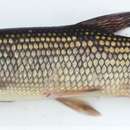Diagnostic Description
(
englanti
)
tarjonnut Fishbase
Diagnosis: Hepsetus lineatus can be distinguished from H. kingsleyae by a larger number of lateral line scales, 50â64 vs. 45â51, and lower number of gill rakers, 12â18, exceptionally 20 in one specimen, vs. 17â23; and by a larger head width, 32.8â46.7 vs. 26.4â35.6% of head length, and larger internasal distance, 21.5â29.3 vs. 15.6â23.3% of head length; the latter two characters are positively allometric (Ref. 93279). Hepsetus lineatus can only be distinguished from H. akawo by a larger number of lateral line scales, 50â64 vs. 43â51, and a smaller number of gill rakers, 12â18, exceptionally up to 20, vs. 17â23 (Ref. 93279). Hepsetus lineatus can be distinguished from H. odoe by a combination of a large internasal distance, 21.5â29.3 vs. 19.5â25.3% of head length, and a small distance between nostril and lower jaw, 36.8â44.4 vs. 40.4â47.6% of head length; both latter characters are positively allometric (Ref. 93279). Hepsetus lineatus can be distinguished from H. cuvieri by a higher number of gill rakers, 12â20 vs. 8â13, a lower number of scales between the dorsal fin and lateral line, 7.5â9.5 vs. 10.5â11.5, a lower number of scales between the adipose fin and lateral line, 4â5.5 vs. 6.5â7.5, and also by a greater head width, 32.8â46.7 vs. 27.8â40.4% of head length, and smaller internasal distance, 21.5â29.3 vs. 27.8â40.4% of head length; latter two characters positively allometric (Ref. 93279).Description: long but relatively broad and stout body; broad head with broad and short snout; head not particularly deep or shallow compared to congeners; dorsal and anal fins in relatively anterior position compared to typical position in congeners; number of lateral line scales high; number of gill rakers on first gill arch low; 4-5.5 scales between adipose fin and lateral line; 2-5 scales between lateral line and pelvic fin, 4-6 between lateral line and anal fin; 14-22 predorsal scales; 15-28 dorsal to adipose scales; 12-23 adipose to caudal scales (Ref. 93279).Colouration: In alcohol: dorsal side of head and body olive greenish to brownish, with gradual change from darker tones dorsally to lighter tones on flanks; belly pale yellowish; pattern of horizontal lines on flanks over entire length of body (from behind opercule to base of caudal fin) resulting from scales having dark upper and lower borders; these lines most prominent in area from approximately 5 scale rows above lateral line down to 2 scale rows below lateral line; lines more prominent on larger animals (larger than about 130mm SL), but sometimes less prominent in individuals from Ivindo River (Gabon) and rivers in Cameroon; sometimes with series of 8-12 greyish vertical bands on dorsolateral parts of body; posterior part of head with 3 well-marked, dark brownish bands running from posterior border of eye to anterior edge of preopercule; bands sometimes faded and poorly visible; lower half of opercule brownish, sometimes blackish; dorsoventrally rounded and elongated blackish spot posterior to head, above lateral line; all fins except adipose fin yellowish with posterior half translucent; caudal fin sometimes darker than other fins and translucent in mid-centre and proximal parts of upper and lower lobes; dorsal, anal and caudal fins with prominent small, roundish, dark brown spots; these spots more prominent on larger animals (larger than about 165mm SL); adipose-fin base yellowish-white, distal part black (Ref. 93279).
- lisenssi
- cc-by-nc
- tekijänoikeus
- FishBase

